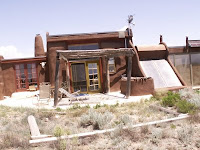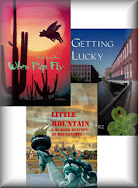
Shiprock, on the Navajo reservation. The region features in much of Tony Hillerman’s work.
June is hot here in Las Cruces, with too many days of 100-plus heat to please us. Our plan was to head north to Santa Fe and beyond in our RV, and damn the price of gasoline. So last Sunday, we decided to load it up for a Monday morning departure. We plugged it in to run the A/C, but the rig draws too many amps, and we kept losing juice. Inside the RV, the air was stifling, which made us both ugly—and then we noticed the blinking red light on the carbon monoxide alarm.
So the next morning, after sleeping off our foul moods, we arranged for someone to care for the cats and then drove north in our car. That was much, much better. Our cats hate to travel anyway. We made no specific plans beyond looking at a map of northwest New Mexico and looking for routes designated as scenic. Our first stop was Santa Fe, our tiny and beautiful state capital. We ate dinner at The Blue Corn Café, where I ate chalupas, described on the menu as “Two yellow corn shells filled with black beans and choice of chicken, ground beef or calabacitas then topped with cheese, chile, lettuce, tomato, sour cream and guacamole.” Muy bien.

At the right is one of the more interesting storefronts. We also stopped in a small shop on 109 East Palace Street that turns out to have been the clearing house for nuclear scientists working in nearby Los Alamos on the Manhattan Project in World War II. A woman told us that each day, scientists would be gathered there, blindfolded, and put on a bus so even they wouldn’t know where they would be working. Monitors watched them closely when they went into Santa Fe in their free time to make sure that no one spoke about the project.

The sign at the right reads in part, “All men and women who made the first atomic bomb passed through this portal to their secret mission at Los Alamos....” The decoration above the plaque prompted the photo.
As lovely as Santa Fe is, we wanted to get out into the countryside, so we skipped out on all the museums we had planned to visit, rationalizing that we aren't big on museums anyway. Not far out of town, we visited Bandelier National
 Monument, with interesting and accessible Indian ruins.
Monument, with interesting and accessible Indian ruins.We didn’t plan to visit Taos, which we had seen once before, but I took a wrong turn and wound up there anyway. In a Burger King parking lot, an elk head caught my attention; it was all trussed and riding on a flat-bed truck. We couldn’t tell if it was a real animal or not. I hope not.
A few miles outside of Taos, we noticed a small neighborhood of strange-looking (to us) homes. We stopped in front of one, and I
 asked for permission to walk around the yard and photograph it. The owner, a 30-something fellow, said he built it himself out of old tires, baled hay, and other recycled materials. Much of the living space is below ground, and some of the other houses have large banks of dirt around them for insulation. He said his heating costs run about $100 per year for propane. No one can blame this fellow for the energy crisis.
asked for permission to walk around the yard and photograph it. The owner, a 30-something fellow, said he built it himself out of old tires, baled hay, and other recycled materials. Much of the living space is below ground, and some of the other houses have large banks of dirt around them for insulation. He said his heating costs run about $100 per year for propane. No one can blame this fellow for the energy crisis. We also found the Rio Grande Gorge, where the river looks mighty compared to its peaceful flow through Las Cruces. I stood on the bridge and took a photo of the breathtaking view hundreds of feet below. That evening at the
We also found the Rio Grande Gorge, where the river looks mighty compared to its peaceful flow through Las Cruces. I stood on the bridge and took a photo of the breathtaking view hundreds of feet below. That evening at the  motel, we turned on the news to learn that a man had just leaped off the bridge; originally, he had been thought to be wearing a parachute that failed to open, but instead he had a backpack and a suicide note.
motel, we turned on the news to learn that a man had just leaped off the bridge; originally, he had been thought to be wearing a parachute that failed to open, but instead he had a backpack and a suicide note.The Carson National Forest was a delight, with the road taking us up to 11,000 feet above sea level and through a vast range of evergreens and snow-dappled mountains. It was June 18, and there were still patches of snow alongside the road.
Our travels took us through several Indian reservations, such as Zia and Pueblo, but the Navajo reservation is the largest in the area. All seem sparsely populated and characterized by casinos, pawn shops, and mobile homes. I wish I could report better news. There is a lot of oil drilling in the region of Shiprock and Farmington, and Halliburton has a presence. Perhaps the various tribes will in time share in whatever wealth the oil fields generate. Perhaps.
Our specific goal in driving to the far northwest was to see Shiprock—the rock, not the town. It is a sacred Navajo site, and truly is a site to behold. That's the picture at the beginning of this post.
We hadn't planned to visit Four Corners until we realized how close we were. It's in the middle of
 the Navajo Nation, and we paid $3 per person to see a circular marker with an “X” in the middle, marking the exact intersection of four states. People stood in line, waiting their turn to stand on the spot, but we were content to watch and to visit a few of the Navajo vendors whose booths surrounded the spot. At the right, this fellow’s left hand is in Utah, his right hand in Arizona; his left foot is in Colorado, and his right foot is in New Mexico.
the Navajo Nation, and we paid $3 per person to see a circular marker with an “X” in the middle, marking the exact intersection of four states. People stood in line, waiting their turn to stand on the spot, but we were content to watch and to visit a few of the Navajo vendors whose booths surrounded the spot. At the right, this fellow’s left hand is in Utah, his right hand in Arizona; his left foot is in Colorado, and his right foot is in New Mexico.We drove up into Colorado and had lunch at the Cyprus Cafe in Durango, a great way to celebrate our 43rd wedding anniversary. The gyro was the best I've ever had.

I don’t mean to end this post on a downbeat, but I must comment on the dozens of roadside memorials we saw. Usually they consist of crosses decorated with flowers, names, dates, and pictures. Sometimes they appeared at dangerous-looking curves, but more often I saw them on straight, wide and benign stretches of highway. This cross, with a painting of a girl in a graduation gown, was one of a pair.

















